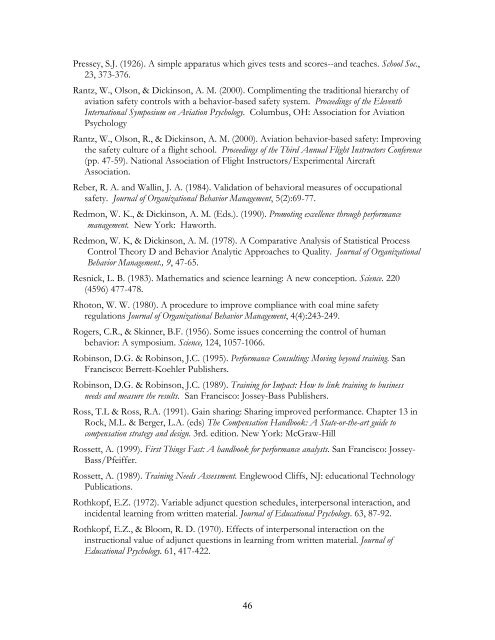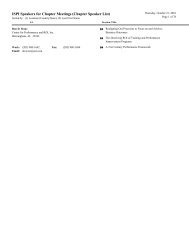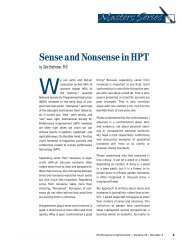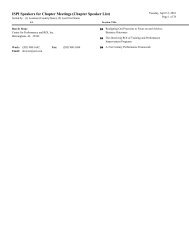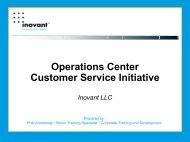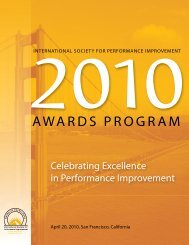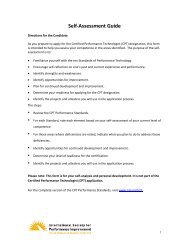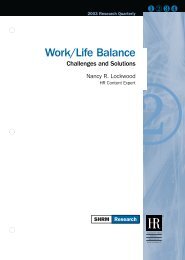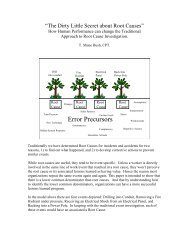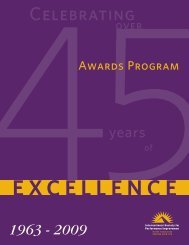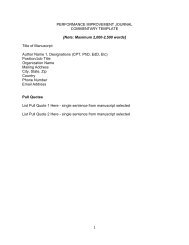Yes We Can! - International Society for Performance Improvement
Yes We Can! - International Society for Performance Improvement
Yes We Can! - International Society for Performance Improvement
Create successful ePaper yourself
Turn your PDF publications into a flip-book with our unique Google optimized e-Paper software.
Pressey, S.J. (1926). A simple apparatus which gives tests and scores--and teaches. School Soc.,<br />
23, 373-376.<br />
Rantz, W., Olson, & Dickinson, A. M. (2000). Complimenting the traditional hierarchy of<br />
aviation safety controls with a behavior-based safety system. Proceedings of the Eleventh<br />
<strong>International</strong> Symposium on Aviation Psychology. Columbus, OH: Association <strong>for</strong> Aviation<br />
Psychology<br />
Rantz, W., Olson, R., & Dickinson, A. M. (2000). Aviation behavior-based safety: Improving<br />
the safety culture of a flight school. Proceedings of the Third Annual Flight Instructors Conference<br />
(pp. 47-59). National Association of Flight Instructors/Experimental Aircraft<br />
Association.<br />
Reber, R. A. and Wallin, J. A. (1984). Validation of behavioral measures of occupational<br />
safety. Journal of Organizational Behavior Management, 5(2):69-77.<br />
Redmon, W. K., & Dickinson, A. M. (Eds.). (1990). Promoting excellence through per<strong>for</strong>mance<br />
management. New York: Haworth.<br />
Redmon, W. K, & Dickinson, A. M. (1978). A Comparative Analysis of Statistical Process<br />
Control Theory D and Behavior Analytic Approaches to Quality. Journal of Organizational<br />
Behavior Management., 9, 47-65.<br />
Resnick, L. B. (1983). Mathematics and science learning: A new conception. Science. 220<br />
(4596) 477-478.<br />
Rhoton, W. W. (1980). A procedure to improve compliance with coal mine safety<br />
regulations Journal of Organizational Behavior Management, 4(4):243-249.<br />
Rogers, C.R., & Skinner, B.F. (1956). Some issues concerning the control of human<br />
behavior: A symposium. Science, 124, 1057-1066.<br />
Robinson, D.G. & Robinson, J.C. (1995). Per<strong>for</strong>mance Consulting: Moving beyond training. San<br />
Francisco: Berrett-Koehler Publishers.<br />
Robinson, D.G. & Robinson, J.C. (1989). Training <strong>for</strong> Impact: How to link training to business<br />
needs and measure the results. San Francisco: Jossey-Bass Publishers.<br />
Ross, T.L & Ross, R.A. (1991). Gain sharing: Sharing improved per<strong>for</strong>mance. Chapter 13 in<br />
Rock, M.L. & Berger, L.A. (eds) The Compensation Handbook: A State-or-the-art guide to<br />
compensation strategy and design. 3rd. edition. New York: McGraw-Hill<br />
Rossett, A. (1999). First Things Fast: A handbook <strong>for</strong> per<strong>for</strong>mance analysts. San Francisco: Jossey-<br />
Bass/Pfeiffer.<br />
Rossett, A. (1989). Training Needs Assessment. Englewood Cliffs, NJ: educational Technology<br />
Publications.<br />
Rothkopf, E.Z. (1972). Variable adjunct question schedules, interpersonal interaction, and<br />
incidental learning from written material. Journal of Educational Psychology. 63, 87-92.<br />
Rothkopf, E.Z., & Bloom, R. D. (1970). Effects of interpersonal interaction on the<br />
instructional value of adjunct questions in learning from written material. Journal of<br />
Educational Psychology. 61, 417-422.<br />
46


